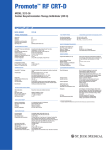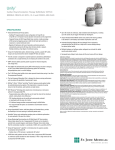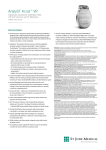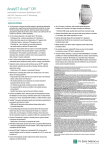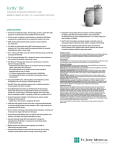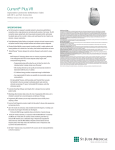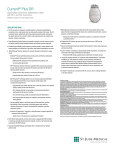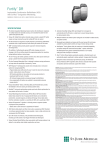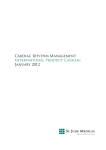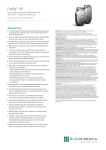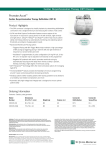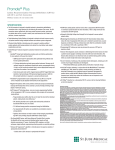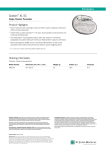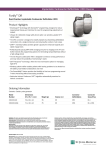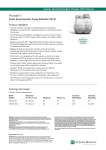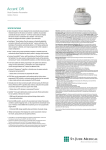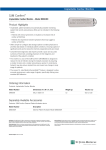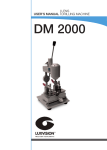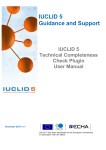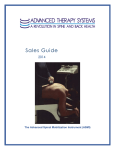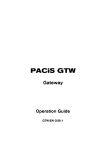Download Current™ DR RF
Transcript
Current™ DR RF with InvisiLink™ Wireless Telemetry MODELS 2207-30 and 2207-36 Implantable Cardioverter Defibrillators (ICDs) SPECIFICATIONS • InvisiLink ™ wireless telemetry frees the clinical team during implant, and streamlines follow-up. InvisiLink RF telemetry uses a dedicated range of frequencies designated for medical devices called the MICS (Medical Implant Communications Service) frequency band, which helps reduce the interference seen on frequencies used by common household electronics. • Designed to reduce unnecessary right ventricular pacing, the VIP algorithm allows intrinsic conduction when possible and provides optimized ventricular support when needed. • Automatic Daily High Voltage Lead Test is designed to ensure patient safety. • Multiple hardware and software system safeguards for added security and patient comfort. • The capability to program multiple ATP schemes per zone has the potential to increase the success of ATP prior to requiring a shock. ® • Our exclusive DeFT Response technology tools provide more clinically proven, non-invasive options for managing high DFTs. – Programmable pulse widths allow the user to tailor the shock to the individual patient, making shocks more efficacious.1 – SVC shocking electrode can be quickly and non-invasively activated or deactivated with the press of a button. – 36 J delivered energy (model 2207-36) provides unsurpassed energy for defibrillation. – Four programmable tilt options are available because no one tilt is optimal for every patient.2 – Together, these features may help to prevent additional surgeries. ™ 1 2 3 4 5 6 Mouchawar G, Kroll M, Val-Mejias JE et al. ICD waveform optimization: a randomized prospective, pair-sampled multicenter study. PACE 2000; 23 (Part II):1992-1995. Sweeney MO, Natale A, Volosin KJ, et al. Prospective randomized comparison of 50%/50% versus 65%/65% tilt biphasic waveform on defibrillation in humans. PACE 2001; 24:60-65. Baker, et al. “Acute Evaluation of Programmer-Guided AV/PV and VV Delay Optimization Comparing an IEGM Method and Echocardiogram for Cardiac Resynchronization Therapy in Heart Failure Patients and Dual-Chamber ICD Implants” Journal of Cardiovascular Electrophysiology, Vol. 18 No. 2, Feb. 2007. Sperzel J, Meine M et al. A new automatic update function of the morphology template used for SVT/VT discrimination in an ICD. Europace Supplements; Vol. 3, July 2002;A 131, #1515. Summary of Safety and Effectiveness, P88086/S83 and P830015/S76; St. Jude Medical. Sharma AD, O'Neill PG, Fain E, et al. Shock on T versus DC for induction of ventricular fibrillation: a randomized prospective comparison. 21st Annual Scientific Session North American Society of Pacing and Electrophysiology (NASPE). Poster presentation published in meeting proceedings. Washington D.C., U.S.A. May 2000. • The SenseAbility ™ feature, with Decay Delay and Threshold Start, provides the flexibility to fine-tune sensing to individual patient needs and help eliminate oversensing of T waves, fractionated QRS complexes, and other extraneous signals. • QuickOpt ™ timing provides quick and effective optimization for more patients at the push of a button.3 – IEGM-based AV optimization allows optimized timing without need for echoguided optimization. • The exclusive Morphology Discrimination plus AV Rate Branch SVT discrimination feature helps reduce the risk of inappropriate ICD shocks and is intended to promote fast, accurate diagnosis and delivery of therapy. Clinical data states that this combination resulted in a sensitivity of 100% with a specificity of 85%.4 • Exclusive AF Suppression ™ algorithm is clinically proven to suppress episodes of paroxysmal and persistent AF. – Studies show a 25% decrease in symptomatic AF burden.5 • Our exclusive DC Fibber ™ induction has a documented 95.5% success rate for inducing fibrillation on the first induction as compared with a 72.7% success rate for Shock-on-T.6 • Exercise trend diagnostic provides insight into the patient’s disease state progression and exercise activity. • There are up to 45 minutes of continuous, fully annotated stored electrograms, including up to 60 seconds of pre-trigger information per electrogram. • Preferential EGM storage capability allows you to prioritize the way episodes are stored. • Exclusive vibratory Patient Notifier allows even patients with hearing problems to be alerted to a low battery, lead-related complications and more. Indications and Usage The Current™ DR RF ICD is intended to provide ventricular antitachycardia pacing and ventricular defibrillation for automated treatment of life-threatening ventricular arrhythmias. AF suppression pacing is indicated for suppression of paroxysmal or persistent atrial fibrilltion in patients with the above ICD indication and sinus node dysfunction. Contraindications Contraindications for use of the pulse generator system include ventricular tachyarrhythmias resulting from transient or correctable factors such as drug toxicity, electrolyte imbalance, or acute myocardial infarction. Warnings and Precautions Resuscitation Availability. Do not perform device testing unless an external defibrillator and medical personnel skilled in cardiopulmonary resuscitation (CPR) are readily available. Lead system. Do not use another manufacturer’s lead system without demonstrated compatibility as undersensing cardiac activity and failure to deliver necessary therapy may result. Avoiding shock during handling. Disable tachyarrhythmia therapy (Enable/Disable Tachy Therapy) or program tachyarrhythmia therapies Off during surgical implant and explant or post-mortem procedures as well as when disconnecting leads as the device can deliver a serious shock if you touch the defibrillation terminals while the device is charged. Additional pacemaker implanted. These devices provide bradycardia pacing. If another pacemaker is used, it should have a bipolar pacing reset mode and be programmed for bipolar pacing to minimize the possibility of the output pulses being detected by the device. Modifying the device. This device has been tested for compliance to FCC regulations. Changes or modifications of any kind not expressly approved by St. Jude Medical Inc. could void the user’s authority to operate this device. Suboptimal radio frequency (RF) communication. The Merlin PCS indicates the quality of the RF communication by the telemetry strength indicator LEDs on both the Merlin PCS and the Merlin Antenna. Please see the User’s Manual for a list of potential causes to suboptimal radio communication. Potential Adverse Events Possible adverse events (in alphabetical order) associated with the system, include, but are not limited to the following: acceleration of arrhythmias (caused by device), air embolism, allergic reaction, bleeding, cardiac tamponade, chronic nerve damage, death, erosion, exacerbation of heart failure, excessive fibrotic tissue growth, extracardiac stimulation (phrenic nerve, diaphragm, chest wall), extrusion, fluid accumulation, formation of hematomas or cysts, inappropriate shocks, infection, keloid formation, lead abrasion and discontinuity, lead migration/dislodgment, myocardial damage, pneumothorax, shunting current or insulating myocardium during defibrillation with internal, or external paddles, Potential mortality due to inability to defibrillate or pace, thromboemboli, venous occlusion, venous or cardiac perforation. Patients susceptible to frequent shocks despite antiarrhythmic medical management, may develop psychological intolerance to an ICD or CRT-D system that may include the following: dependency, depression, fear of premature battery depletion, fear of shocking while conscious, fear of losing shock capability, imagined shocking (phantom shock). Refer to the User’s Manual for detailed indications, contraindications, warnings, precautions and potential adverse events. Current DR RF Models 2207-30 and 2207-36 Implantable Cardioverter Defibrillators MODEL NUMBER 2207-30 2207-36 RF and Inductive 30 J 38 74 76 x 50 x 13 DF-1 IS-1 Electrically active titanium can RF and Inductive 36 J 42 80 77 x 50 x 14 DF-1 IS-1 Electrically active titanium can PHYSICAL SPECIFICATIONS Telemetry Delivered Energy Volume (cc) Weight (g) Size (mm) Defibrillation Lead Connections Sense/Pace Lead Connections High Voltage Can Post-Therapy Pacing (Independently programmable from Bradycardia and ATP) Post-Shock Pacing Mode Post-Shock Base Rate (ppm) Post-Shock Pacing Duration (min) Post-Shock Atrial Pacing Amplitude (V) Post-Shock Ventricular Pacing Amplitude (V) Post-Shock Pacing Pulse Width (ms) Off, AAI, VVI, DDI, or DDD 30-100 in increments of 5 Off, 0.5, 1, 2.5, 5, 7.5, or 10 0.25 to 7.5 0.25 to 7.5 0.05, 0.1-1.5 Device Testing/Induction Methods PARAMETER SETTINGS AF Management AF Suppression™ Pacing No. of Overdrive Pacing Cycles Maximum AF Suppression Rate Off; On 15-40 in increments of 5 80-150 ppm Threshold Start Decay Delay Ventricular Sense Refractory (ms) Detection Zones SVT Discriminators Reconfirmation Automatic Sensitivity Control adjustment for atrial and ventricular events (Post-Sensed, Atrial) 50, 62.5, 75, 100%; (Post-Paced, Atrial) 0.2-3.0 mV; (Post-Sensed, Ventricular) 50, 62.5, 75, 100%; (Post-Paced, Ventricular) Auto, 0.2-3.0 mV (Post-Sense/Post-Pace, Atrial/Ventricular) 0-220 125, 157 VT-1, VT-2, VF AV Rate Branch, Sudden Onset, Interval Stability, Morphology Discrimination (MD) with Manual or Automatic Template Update Continuous sensing during charging Therapy Summary Episodes Summary Lifetime Diagnostics AT/AF Burden Trend Ventricular HV Lead Impedance Trend Histograms Antitachycardia Pacing Therapy ATP Configurations Burst Cycle Length Min. Burst Cycle Length (ms) Number of Bursts Number of Stimuli Add Stimuli per Burst ATP Pulse Amplitude (V) ATP Pulse Width (ms) Ramp, Burst, Scan; 1 or 2 schemes per zone Adaptive, Readaptive or Fixed 150-400 in increments of 5 1-15 2-20 On, Off 7.5 Independent from Bradycardia and Post-Therapy Pacing 1.0 or 1.5; Independently programmable from Bradycardia and Post-Therapy Pacing High Voltage Therapy Waveform RV Polarity Electrode Configuration Biphasic, Monophasic Cathode (-), Anode (+) RV to Can, RV to SVC/Can 0.5-5.0 20-100 2-25 stimuli with up to three extrastimuli Electrograms and Diagnostics Stored Electrograms Sensing/Detection SenseAbility™ Technology DC Fibber™ Pulse Duration (sec) Burst Fibber Cycle Length (ms) Noninvasive Programmed Stimulation (NIPS) PMT Data Real-Time Measurements (RTM) Up to 45 minutes including up to one minute programmable pre-trigger data per VT/VF diagnosis/detection electrograms; triggers include diagnosis, therapy, atrial episode, PMT termination, PC shock delivery, noise reversion, magnet reversion, and morphology template verification Diagram of therapies delivered Directory listing of up to 60 episodes with access to more details including stored electrograms History of bradycardia events and deviceinitiated charging Trend data and counts Multi-Vector Trend Data Event Histogram, AV Interval Histogram, Mode Switch Duration Histogram, Peak Filtered Rate Histogram, Atrial Heart Rate Histogram, Ventricular Heart Rate Histogram, AT/AF Burden, Exercise and Activity Trending, V Rates during AMS Information regarding PMT detections Pacing lead impedances, High voltage lead impedances, unloaded battery voltage, and signal amplitudes Patient Notifiers Device at ERI Charge Time Limit Reached Possible HV Circuit Damage Device Reset Atrial Lead Impedance (out of range) Ventricular Lead Impedance (out of range) High Voltage Lead Impedance (out of range) Entry into Backup VVI Mode Vibration Duration (sec) Number of Vibrations per Notification Number of Notifications Time Between Notifications (hours) Off, On Off, On Off, On On Off, On Off, On Off, On On 2, 4, 6, 8, 10, 12, 14, 16 2 1-16 10, 22 Bradycardia Pacing Permanent Modes Temporary Modes Rate-Adaptive Sensor Programmable Rate Parameters QuickOpt™ Timing Cycle Optimization Auto Mode Switch (AMS) AMS Detection Rate (ppm) AMS Switch Base Rate (ppm) Auto PMT Detection/Termination Rate Responsive PVARP/VREF Ventricular Intrinsic Preference (VIP®) Cardiac Rhythm Management Division 15900 Valley View Court Sylmar, CA 91342 USA 888 SJM-CRMD 818 362-6822 818 362-7182 Fax www.sjm.com DDD(R), DDI(R), VVI(R), AAI(R), Pacer Off Off, DDD, DDI, VVI, AAI, AAT, DOO, VOO, AOO On, Off, Passive Off, Base Rate (ppm), Rest Rate (ppm), Maximum Tracking Rate (ppm), Maximum Sensor Rate (ppm), Paced AV Delay (ms), Sensed AV Delay (ms), Rate Responsive AV Delay, Pulse Amplitude (Atrial, RV) (V), Pulse Width (Atrial, RV and LV) (ms), Hysteresis Rate (ppm), Rate Hysteresis with Search Sensed/paced AV delay Off, DDI(R), VVI(R) 110-300 40, 45,...135 A Pace on PMT, Off, Passive Off, Low, Medium, High Off, 50-200 (50-150 in increments of 25; 160-200 in increments of 10) St. Jude Medical AB Veddestavägen 19 SE-175 84 Järfälla SWEDEN +46 8 474 4000 +46 8 760 9542 Fax Ordering No. XXXXX Printed in USA 080710 CAUTION: FEDERAL LAW (USA) RESTRICTS THIS DEVICE TO SALE, DISTRIBUTION AND USE BY OR ON THE ORDER OF A PHYSICIAN. Consult the User’s Manual for information on indications, contraindications, warnings and precautions. Unless otherwise noted, ™ indicates that the name is a trademark of, or licensed to, St. Jude Medical, or one of its subsidiaries. © 2007 St. Jude Medical Cardiac Rhythm Management Division. All rights reserved.


